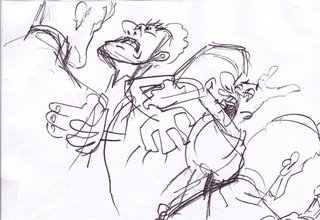Here's a question for the film buffs out there: what non-Hitchcock film most closely resembles the kind of film Hitchcock used to make? "Diabolique"? "Charade?" "Arsenic and Old Lace"? "Portrait of Jenny"? I say none of the above. For me the film that most approximates Hitchcock is the 1953 Technicolor thriller, "Niagara," directed by Henry Hathaway.
Niagara had some classic Hitchcock icons: the imposing falls at Niagara, the hint of fate, a menacing supernatural presence, and the characters who dare to venture into the abyss and are unable to extricate themselves.
The film must have rattled Hitchcock. It must have seemed like the industry was on to him, that all his innovations were on the verge of becoming standard practice. It's tempting to speculate that his response was to remake Niagara, and do it in such a way that it would be clear to everyone that only Hitchcock could do Hitchcock. That remake would have been "Vertigo."
I remind the reader that Hitchcock was famous for his use of monumental icons. Here, from Hitchcock's "Saboteur" is a shot from the fight scene on the torch of the Statue of Liberty.
Taking a page from Hitchcock, Hathaway staked his claim to Niagara Falls (above). For Vertigo, Hitchcock would have to find something else.
And he did...San Francisco and, in particular, The Golden Gate Bridge. It's a water motif again, only with a more art directed feel. The awe-inspiring bridge is made to feel like the creepy entrance to another world.
Hathaway also flirted with the idea of another world with a doorway into our own. From Niagara, that's (above) the monumental arch that used to grace the Canadian side of the falls. Arches are a classic surrealist symbol for the beckoning unknown.
Vertigo (above) employed a similar arch.
Niagara (above) is about a man's obsession for a woman.
So is Vertigo (above).
Niagara's climax takes place in a bell tower (above).
So does Vertigo (above).
Above, the corpse in Niagara
Above, the corpse in Vertigo.
Niagara starred the openly sensuous Marilyn Monroe. For Hitchcock this was a mistake. He's quoted as saying:
“As for myself, I prefer a woman who does not display all of her sex at once – one whose attractions are not falling out in front of her. I like women who are also ladies, who hold enough of themselves in reserve to keep a man intrigued.... When a man approaches her, the audience should be led to wonder whether she intends to shrink from him or tear off his clothes.”
Hitchcock's lady was Kim Novak. I think he would have preferred Grace Kelly.
One final speculation: Vertigo was a marvelous film but I'm guessing that Hitchcock felt he'd lost control over it and made a film the public wouldn't understand. Even so, the taste of freedom and experiment was intoxicating and Hitch found he couldn't go back to the type of film he'd made before. At the threshold of old age, and at great risk to his career, he cast about for something new, and that search would eventually lead to "Psycho" and "The Birds."
That's all I have room for here. Before I go let me thank Joel Gunz. Some of the opinions and pictures here are stolen from his excellent blog:
http://www.alfredhitchcockgeek.com/search/label/Niagara

































































